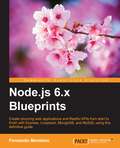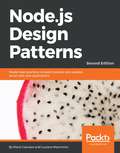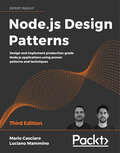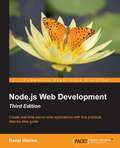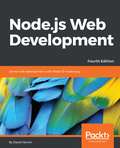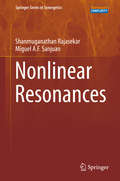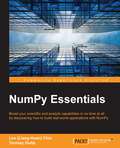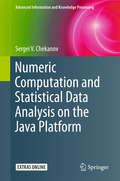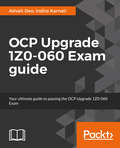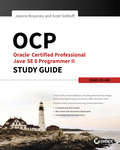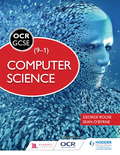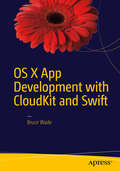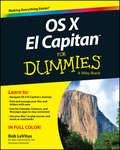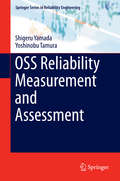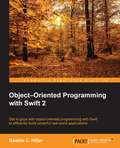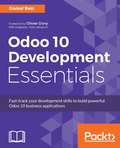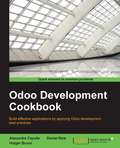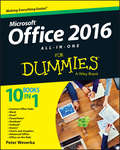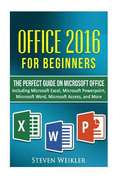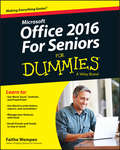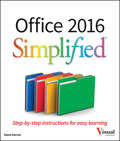- Table View
- List View
Node.js 6.x Blueprints
by Fernando MonteiroCreate stunning web applications and Restful APIs from start to finish with Express, Loopback, MongoDB, and MySQL using this definitive guide About This Book * Create stunning applications with Node.js from scratch, no matter the goal * Discover a wide variety of applications you can effectively integrate third-party libraries and other front-end frameworks with Node.js * Leverage all the new features introduced in Node.js 6.X Who This Book Is For This book caters to developers who are looking to build projects right from a simple website to more complex one such as a blog, chat application, a photography site, and a lot more. A Basic knowledge of JavaScript and Node.js would be extremely beneficial. What You Will Learn * Explore MVC design pattern in Node.js * Build solid architectures by following test-driven development * Look beyond web applications and create your own desktop app with Node.js * Develop single page applications using Node.js with the RESTful APIs, MongoDB, and ORM * Master the Express framework and build a complete application with a real database * Create a real-time and fully functional online chat application with Socket.IO In Detail Node.js is the most popular framework to create server-side applications today. Be it web, desktop, or mobile, Node.js comes to your rescue to create stunning real-time applications. Node.js 6.x Blueprints will teach you to build these types of projects in an easy-to-understand manner. The key to any Node.js project is a strong foundation on the concepts that will be a part of every project. The book will first teach you the MVC design pattern while developing a Twitter-like application using Express.js. In the next chapters, you will learn to create a website and applications such as streaming, photography, and a store locator using MongoDB, MySQL, and Firebase. Once you're warmed up, we'll move on to more complex projects such as a consumer feedback app, a real-time chat app, and a blog using Node.js with frameworks such as loopback.io and socket.io. Finally, we'll explore front-end build processes, Docker, and continuous delivery. By the end of book, you will be comfortable working with Node.js applications and will know the best tools and frameworks to build highly scalable desktop and cloud applications. Style and approach This is an easy-to-follow guide full of practical examples. This book takes a project-based approach and each chapter contains step-by-step instructions to create stunning applications across different application domains from scratch.
Node.js Design Patterns - Second Edition
by Mario Casciaro Luciano MamminoGet the best out of Node.js by mastering its most powerful components and patterns to create modular and scalable applications with ease About This Book * Create reusable patterns and modules by leveraging the new features of Node.js . * Understand the asynchronous single thread design of node and grasp all its features and patterns to take advantage of various functions. * This unique guide will help you get the most out of Node.js and its ecosystem. Who This Book Is For The book is meant for developers and software architects with a basic working knowledge of JavaScript who are interested in acquiring a deeper understanding of how to design and develop enterprise-level Node.js applications. Basic knowledge of Node.js is also helpful to get the most out of this book. What You Will Learn * Design and implement a series of server-side JavaScript patterns so you understand why and when to apply them in different use case scenarios * Become comfortable with writing asynchronous code by leveraging constructs such as callbacks, promises, generators and the async-await syntax * Identify the most important concerns and apply unique tricks to achieve higher scalability and modularity in your Node.js application * Untangle your modules by organizing and connecting them coherently * Reuse well-known techniques to solve common design and coding issues * Explore the latest trends in Universal JavaScript, learn how to write code that runs on both Node.js and the browser and leverage React and its ecosystem to implement universal applications In Detail Node.js is a massively popular software platform that lets you use JavaScript to easily create scalable server-side applications. It allows you to create efficient code, enabling a more sustainable way of writing software made of only one language across the full stack, along with extreme levels of reusability, pragmatism, simplicity, and collaboration. Node.js is revolutionizing the web and the way people and companies create their software. In this book, we will take you on a journey across various ideas and components, and the challenges you would commonly encounter while designing and developing software using the Node.js platform. You will also discover the "Node.js way" of dealing with design and coding decisions. The book kicks off by exploring the basics of Node.js describing it's asynchronous single-threaded architecture and the main design patterns. It then shows you how to master the asynchronous control flow patterns,and the stream component and it culminates into a detailed list of Node.js implementations of the most common design patterns as well as some specific design patterns that are exclusive to the Node.js world.Lastly, it dives into more advanced concepts such as Universal Javascript, and scalability' and it's meant to conclude the journey by giving the reader all the necessary concepts to be able to build an enterprise grade application using Node.js. Style and approach This book takes its intended readers through a comprehensive explanation to create a scalable and efficient real-time server-side apps.
Node.js Design Patterns: Design and implement production-grade Node.js applications using proven patterns and techniques, 3rd Edition
by Mario Casciaro Luciano MamminoLearn proven patterns, techniques, and tricks to take full advantage of the Node.js platform. Master well-known design principles to create applications that are readable, extensible, and that can grow big. Key Features Learn how to create solid server-side applications by leveraging the full power of Node.js 14 Understand how Node.js works and learn how to take full advantage of its core components as well as the solutions offered by its ecosystem Avoid common mistakes and use proven patterns to create production grade Node.js applications Book Description In this book, we will show you how to implement a series of best practices and design patterns to help you create efficient and robust Node.js applications with ease. We kick off by exploring the basics of Node.js, analyzing its asynchronous event driven architecture and its fundamental design patterns. We then show you how to build asynchronous control flow patterns with callbacks, promises and async/await. Next, we dive into Node.js streams, unveiling their power and showing you how to use them at their full capacity. Following streams is an analysis of different creational, structural, and behavioral design patterns that take full advantage of JavaScript and Node.js. Lastly, the book dives into more advanced concepts such as Universal JavaScript, scalability and messaging patterns to help you build enterprise-grade distributed applications. Throughout the book, you'll see Node.js in action with the help of several real-life examples leveraging technologies such as LevelDB, Redis, RabbitMQ, ZeroMQ, and many others. They will be used to demonstrate a pattern or technique, but they will also give you a great introduction to the Node.js ecosystem and its set of solutions. What you will learn Become comfortable with writing asynchronous code by leveraging callbacks, promises, and the async/await syntax Leverage Node.js streams to create data-driven asynchronous processing pipelines Implement well-known software design patterns to create production grade applications Share code between Node.js and the browser and take advantage of full-stack JavaScript Build and scale microservices and distributed systems powered by Node.js Use Node.js in conjunction with other powerful technologies such as Redis, RabbitMQ, ZeroMQ, and LevelDB Who this book is for This book is for developers and software architects who have some prior basic knowledge of JavaScript and Node.js and now want to get the most out of these technologies in terms of productivity, design quality, and scalability. Software professionals with intermediate experience in Node.js and JavaScript will also find valuable the more advanced patterns and techniques presented in this book. This book assumes that you have an intermediate understanding of web application development, databases, and software design principles.
Node.js Web Development - Third Edition
by David HerronCreate real-time server-side applications with this practical, step-by-step guide About This Book * Learn about server-side JavaScript with Node.js and Node modules through the most up-to-date book on Node.js web development * Understand website development both with and without the Connect/Express web application framework * Develop both HTTP server and client applications Who This Book Is For This book is for anybody looking for an alternative to the "P" languages (Perl, PHP, and Python), or anyone looking for a new paradigm of server-side application development. You should have at least a rudimentary understanding of JavaScript and web application development. What You Will Learn * Install and use Node.js for both development and deployment * Use the Express application framework * Configure Bootstrap for mobile-first theming * Use data storage engines such as MySQL, SQLITE3, and MongoDB * Understand user authentication methods, including OAuth, with third-party services * Deploy Node.js to live servers, including microservice development with Docker * Perform unit testing with Mocha * Perform functional testing of the web application with CasperJS In Detail Node.js is a server-side JavaScript platform using an event driven, non-blocking I/O model allowing users to build fast and scalable data-intensive applications running in real time. Node.js Web Development shows JavaScript is not just for browser-side applications. It can be used for server-side web application development, real-time applications, microservices, and much more. This book gives you an excellent starting point, bringing you straight to the heart of developing web applications with Node.js. You will progress from a rudimentary knowledge of JavaScript and server-side development to being able to create and maintain your own Node.js application. With this book you'll learn how to use the HTTP Server and Client objects, data storage with both SQL and MongoDB databases, real-time applications with Socket.IO, mobile-first theming with Bootstrap, microservice deployment with Docker, authenticating against third-party services using OAuth, and much more. Style and Approach This book is a practical guide for anyone looking to develop striking and robust web applications using Node.js.
Node.js Web Development: Server-side development with Node 10 made easy, 4th Edition
by David HerronCreate real-time applications using Node.js 10, Docker, MySQL, MongoDB, and Socket.IO with this practical guide and go beyond the developer's laptop to cover live deployment, including HTTPS and hardened security.Key FeaturesLearn server-side JavaScript coding through the most up-to-date book on Node.jsExplore the latest JavaScript features, and EcmaScript modulesWalk through different stages of developing robust applications using Node.js 10Book Description Node.js is a server-side JavaScript platform using an event-driven, non-blocking I/O model allowing users to build fast and scalable data-intensive applications running in real time. This book gives you an excellent starting point, bringing you straight to the heart of developing web applications with Node.js. You will progress from a rudimentary knowledge of JavaScript and server-side development to being able to create, maintain, deploy and test your own Node.js application.You will understand the importance of transitioning to functions that return Promise objects, and the difference between fs, fs/promises and fs-extra. With this book you'll learn how to use the HTTP Server and Client objects, data storage with both SQL and MongoDB databases, real-time applications with Socket.IO, mobile-first theming with Bootstrap, microservice deployment with Docker, authenticating against third-party services using OAuth, and use some well known tools to beef up security of Express 4.16 applications.What you will learnInstall and use Node.js 10 for both development and deploymentUse the Express 4.16 application frameworkWork with REST service development using the Restify frameworkUse data storage engines such as MySQL, SQLITE3, and MongoDBUse User authentication methods with OAuth2Perform Real-time communication with the front-end using Socket.IOImplement Docker microservices in development, testing and deployment Perform unit testing with Mocha 5.x, and functional testing with Puppeteer 1.1.xWork with HTTPS using Let’s Encrypt, and application security with HelmetWho this book is forThis book is for anybody looking for an alternative to the "P" languages (Perl, PHP, and Python), or anyone looking for a new paradigm of server-side application development. You should have at least a rudimentary understanding of JavaScript and web application development.
Nonlinear Resonances
by Shanmuganathan Rajasekar Miguel A.F. SanjuanThis introductory text presents the basic aspects and most important features of various types of resonances and anti-resonances in dynamical systems. In particular, for each resonance, it covers the theoretical concepts, illustrates them with case studies, and reviews the available information on mechanisms, characterization, numerical simulations, experimental realizations, possible quantum analogues, applications and significant advances made over the years. Resonances are one of the most fundamental phenomena exhibited by nonlinear systems and refer to specific realizations of maximum response of a system due to the ability of that system to store and transfer energy received from an external forcing source. Resonances are of particular importance in physical, engineering and biological systems - they can prove to be advantageous in many applications, while leading to instability and even disasters in others. The book is self-contained, providing the details of mathematical derivations and techniques involved in numerical simulations. Though primarily intended for graduate students, it can also be considered a reference book for any researcher interested in the dynamics of resonant phenomena.
Now the Chips Are Down: The BBC Micro (Platform Studies)
by Alison GazzardThe story of a pioneering microcomputer: its beginnings as part of a national Computer Literary Project, its innovative hardware, and its creative uses.In 1982, the British Broadcasting Corporation launched its Computer Literacy Project, intended “to introduce interested adults to the world of computers and computing.” The BBC accompanied this initiative with television programs, courses, books, and software—an early experiment in multi-platform education. The BBC, along with Acorn Computers, also introduced the BBC Microcomputer, which would be at the forefront of the campaign. The BBC Micro was designed to meet the needs of users in homes and schools, to demystify computing, and to counter the general pessimism among the media in Britain about technology. In this book, Alison Gazzard looks at the BBC Micro, examining the early capabilities of multi-platform content generation and consumption and the multiple literacies this approach enabled—not only in programming and software creation, but also in accessing information across a range of media, and in “do-it-yourself” computing. She links many of these early developments to current new-media practices.Gazzard looks at games developed for the BBC Micro, including Granny's Garden, an educational game for primary schools, and Elite, the seminal space-trading game. She considers the shift in focus from hardware to peripherals, describing the Teletext Adapter as an early model for software distribution and the Domesday Project (which combined texts, video, and still photographs) as a hypermedia-like experience. Gazzard's account shows the BBC Micro not only as a vehicle for various literacies but also as a user-oriented machine that pushed the boundaries of what could be achieved in order to produce something completely new.
NumPy Essentials
by Tanmay Dutta Leo Liang-Huan ChinBoost your scientific and analytic capabilities in no time at all by discovering how to build real-world applications with NumPy About This Book * Optimize your Python scripts with powerful NumPy modules * Explore the vast opportunities to build outstanding scientific/ analytical modules by yourself * Packed with rich examples to help you master NumPy arrays and universal functions Who This Book Is For If you are an experienced Python developer who intends to drive your numerical and scientific applications with NumPy, this book is for you. Prior experience or knowledge of working with the Python language is required. What You Will Learn * Manipulate the key attributes and universal functions of NumPy * Utilize matrix and mathematical computation using linear algebra modules * Implement regression and curve fitting for models * Perform time frequency / spectral density analysis using the Fourier Transform modules * Collate with the distutils and setuptools modules used by other Python libraries * Establish Cython with NumPy arrays * Write extension modules for NumPy code using the C API * Build sophisticated data structures using NumPy array with libraries such as Panda and Scikits In Detail In today's world of science and technology, it's all about speed and flexibility. When it comes to scientific computing, NumPy tops the list. NumPy gives you both the speed and high productivity you need. This book will walk you through NumPy using clear, step-by-step examples and just the right amount of theory. We will guide you through wider applications of NumPy in scientific computing and will then focus on the fundamentals of NumPy, including array objects, functions, and matrices, each of them explained with practical examples. You will then learn about different NumPy modules while performing mathematical operations such as calculating the Fourier Transform; solving linear systems of equations, interpolation, extrapolation, regression, and curve fitting; and evaluating integrals and derivatives. We will also introduce you to using Cython with NumPy arrays and writing extension modules for NumPy code using the C API. This book will give you exposure to the vast NumPy library and help you build efficient, high-speed programs using a wide range of mathematical features. Style and approach This quick guide will help you get to grips with the nitty-gritties of NumPy using with practical programming examples. Each topic is explained in both theoretical and practical ways with hands-on examples providing you efficient way of learning and adequate knowledge to support your professional work.
Numeric Computation and Statistical Data Analysis on the Java Platform
by Sergei V. V. ChekanovNumericalcomputation, knowledge discovery and statistical data analysis integrated withpowerful 2D and 3D graphics for visualization are the key topics of this book. ThePython code examples powered by the Java platform can easily be transformed toother programming languages, such as Java, Groovy, Ruby and BeanShell. Thisbook equips the reader with acomputational platform which, unlike other statistical programs, is not limitedby a single programming language. The authorfocuses on practical programming aspects and covers a broad range of topics,from basic introduction to the Python language on the Java platform (Jython),to descriptive statistics, symbolic calculations, neural networks, non-linearregression analysis and many other data-mining topics. He discusses how to findregularities in real-world data, how to classify data, and how to process datafor knowledge discoveries. The code snippets are so short that they easily fit intosingle pages. Numeric Computation and Statistical DataAnalysis on the Java Platform is a great choice for those who want to learn how statisticaldata analysis can be done using popular programming languages, who want tointegrate data analysis algorithms in full-scale applications, and deploy suchcalculations on the web pages or computational servers regardlessof their operating system. It is an excellent reference for scientific computations to solvereal-world problems using a comprehensive stack of open-source Javalibraries included in the DataMelt (DMelt) project and will beappreciated by many data-analysis scientists, engineers and students.
Numerical Analysis Using R
by Graham W. GriffithsThis book presents the latest numerical solutions to initial value problems and boundary value problems described by ODEs and PDEs. The author offers practical methods that can be adapted to solve wide ranges of problems and illustrates them in the increasingly popular open source computer language R, allowing integration with more statistically based methods. The book begins with standard techniques, followed by an overview of 'high resolution' flux limiters and WENO to solve problems with solutions exhibiting high gradient phenomena. Meshless methods using radial basis functions are then discussed in the context of scattered data interpolation and the solution of PDEs on irregular grids. Three detailed case studies demonstrate how numerical methods can be used to tackle very different complex problems. With its focus on practical solutions to real-world problems, this book will be useful to students and practitioners in all areas of science and engineering, especially those using R.
O Kung Fu da Linha de Comando
by Jason Cannon Rafaella C. S. BarrosTorne-se um ninja do Linux com O Kung Fu da Linha de Comando! Você acha que tem que se trancar no porão lendo páginas incompreensíveis por meses a fio para ter habilidades de linha de comando como um ninja? Na verdade, se alguém compartilhasses as dicas, truques e padrões mais poderosos da linha de comando, você economizaria muito tempo. E se você pudesse aprender com alguém que é um guru da linha de comando? E se ele mostrasse os comandos que está usando e por que está usando e como exatamente eles funcionam? E se ele escrevesse tudo isso, para que você pudesse consultar sempre que quisesse? O Kung Fu da Linha de Comando está repleto de muitas dicas e mais de 100 exemplos práticos do mundo real. Não há exemplos teóricos nesse livro. Os exemplos demonstram como solucionar problemas reais e realizar objetivos que valem a pena. As táticas são fáceis de encontrar. Cada capítulo cobre um tópico específico e agrupa dicas e exemplos relacionados juntos. Por exemplo, se você precisa de ajuda extraindo texto de um arquivo, procure no capítulo "Processamento e Manipulação de Textos". Além disso, foi incluído um índice extensivo. Se você quiser encontrar todas as ocorrências de onde um dado comando é usado -- mesmo que não seja o assunto principal -- procure no índice. Eis algumas das coisas que você irá aprender: Como repetir comandos rápida e facilmente no seu histórico da shell Atalhos para obter palavras do seu histórico e usar no seu comando atual Como salvar uma cópia da sua sessão para consulta posterior Como remover linhas em branco e comentários de arquivos Como controlar texto colorido ao usar "pipes" e paginadores Transformando o texto: alteração de caixa, substituição de caracteres, etc. Como extrair blocos de texto de arquivos ou fluxos de entrada Um dica rápida para erros de digitação comuns Como editar arquivos sobre a rede Comparando as diferenças entre
OCP 12c Upgrade 1Z0-060 Exam Guide
by Advait Deo Indira KarnatiYour ultimate guide to passing the OCP 12c Upgrade 1Z0-060 Exam About This Book * This is your one-stop solution to understanding what's new in Oracle 12c and how to bring these features to your systems in a hassle-free manner * A complete guide to clearing the OCP Upgrade 1Z0-060 Exam * Dive deep into Oracle administration and get up to date Who This Book Is For This book is for Oracle Admins who have a working knowledge of Oracle administration and now want to upgrade their knowledge to the latest version (Oracle 12c). This book is perfect for those who wish to pass the OCP Upgrade 1Z0-060 Exam. What You Will Learn * All of the new features of the Oracle 12c database that you are required to know for the OCP Upgrade Exam 1Z0-060 * New multitenant architecture introduced in Oracle 12c and how it works * Monitor complex database operations and use the new enhanced SQL tuning features to tune bad SQLs * Manage data over time using information life cycle management * Make your data more secure by implementing new enhanced auditing * Learn new security features and how to implement encryption to secure your data * Explore how backup and flashback works with new multitenant architecture * Performance management techniques that will analyze and tune your database In Detail This guide will get Oracle admins up to date with the latest developments in Oracle 12c. It includes all the necessary information that you need to implement in your existing systems. All of the information in this book has been handpicked to help you study for the Oracle 12c upgrade exam. Each chapter has been written with the objective of helping you pass this exam with ease. Content in this book is aligned with the objectives of the exam, making it really easy to follow the course content. Every example mentioned in this book has been tried and tested in actual environment. Real-world examples will help you learn about new features such as multitenant containers database architecture, managing containers, pluggable databases, database administration enhancements, database auditing, tuning, backup, and flashback enhancements. You will also learn about storage enhancements, security updates, tuning, troubleshooting, and backup enhancements. This book also covers section 2 of the exam course making this book a complete guide for passing OCP 12c upgrade exam 1Z0-060. Style and approach This book systematically covers various aspects of Oracle administration and provides the information necessary to pass the OCP Upgrade 1Z0-060 Exam Set 1 and Set 2.
OCP: Exam 1z0-809
by Scott Selikoff Jeanne BoyarskyComplete, trusted preparation for the Java Programmer II exam OCP: Oracle Certified Professional Java SE 8 Programmer II Study Guide is your comprehensive companion for preparing for Exam 1Z0-809 as well as upgrade Exam 1Z0-810 and Exam 1Z0-813. With full coverage of 100% of exam objectives, this invaluable guide reinforces what you know, teaches you what you don't know, and gives you the hands-on practice you need to boost your skills. Written by expert Java developers, this book goes beyond mere exam prep with the insight, explanations and perspectives that come from years of experience. You'll review the basics of object-oriented programming, understand functional programming, apply your knowledge to database work, and much more. From the basic to the advanced, this guide walks you through everything you need to know to confidently take the OCP 1Z0-809 Exam and upgrade exams 1Z0-810 and 1Z0-813. Java 8 represents the biggest changes to the language to date, and the latest exam now requires that you demonstrate functional programming competence in order to pass. This guide has you covered, with clear explanations and expert advice. Understand abstract classes, interfaces, and class design Learn object-oriented design principles and patterns Delve into functional programming, advanced strings, and localization Master IO, NIO, and JDBC with expert-led database practice If you're ready to take the next step in your IT career, OCP: Oracle Certified Professional Java SE 8 Programmer II Study Guide is your ideal companion on the road to certification.
OCR Computer Science for GCSE Student Book
by George Rouse Sean O'ByrneBuild student confidence and ensure successful progress through GCSE Computer Science. Our expert authors provide insight and guidance to meet the demands of the new OCR specification, with challenging tasks and activities to test the computational skills and knowledge required for success in their exams, and advice for successful completion of the non-examined assessment.- Builds students' knowledge and confidence through detailed topic coverage and explanation of key terms- Develops computational thinking skills with practice exercises and problem-solving tasks- Ensures progression through GCSE with regular assessment questions, that can be developed with supporting Dynamic Learning digital resources- Instils a deeper understanding and awareness of computer science, and its applications and implications in the wider world
OS X App Development with CloudKit and Swift
by Bruce WadeOS X App Development with CloudKit and Swift is your step-by-step guide to learning OS X app development using CloudKit and Swift. You will use CloudKit to create data-driven apps using only Apple technologies. Using this book, you will learn how to define the data for your app and build a prototype using Sketch 3 and Keynote. You will use CloudKit to store your OS X application data, separate public and private data, and control what data a user can or can not change in your public data store. All the development will be done using Apple's Swift 2 programming language, which you should have an understanding of already. This book takes you from prototyping your app with Sketch 3 all the way through building a data-driven app using CloudKit, and everything in between - add it to your library today. What you'll learn Learn how to prototype an OS X app using Sketch 3 Use CloudKit to build dynamic data-driven apps Use Swift 2 Apple's new programming language Who this book is for OS X App Development with CloudKit and Swift is for the iOS or OS X developer who is struggling to get to grips with CloudKit. If you're looking for a solid example from start to finish using CloudKit with Swift 2 this book's for you. You should have an understanding of the Swift language, e. g. the differences between var/let, how to work with control statements, closures etc. , to work confidently with this book.
OS X El Capitan For Dummies
by Bob LevitusGet up to speed on the latest Mac OS Getting a new Mac and not knowing how to use it is like getting a remote controlled car for Christmas with no batteries. OS X For Dummies powers your understanding of the latest Mac operating system through straightforward, fun content that covers the basic features and functions you need to know. An essential text if you're not already familiar with Apple technology, this resource walks you through the fundamentals of Apple's Mac OS, shows you how to customize your workspace, work with the Dock, leverage the Finder and Finder Tabs, understand files, folders, and tags, find things with Spotlight, use Mission Control and Launchpad, organize your life through Calendar, Reminders, Notes, and Notifications, and much more. Apple is one of the most popular technology companies in the world, known for its ability to combine power and stability with style. Since all of Apple's products function according to its proprietary operating system, it's essential that you understand how to use the OS to make the most of your tech toys. Take your communication to the next level with email and messaging capabilities Enjoy multi-media entertainment by surfing the web and accessing movies, music, ebooks, and digital photos Let your creative side run free with Text Edit Create a seamless digital experience by connecting a printer, running multiple displays, networking, file sharing, backing up and restoring your system, and keeping your machine safe with Gatekeeper OS X For Dummies breaks down Apple's Mac operating system into bite-sized pieces, allowing you to digest small morsels of information that guide you in navigating your new Apple gadget.
OSS Reliability Measurement and Assessment
by Shigeru Yamada Yoshinobu TamuraThis book analyses quantitative open source software (OSS) reliability assessment and its applications, focusing on three major topic areas: the Fundamentals of OSS Quality/Reliability Measurement and Assessment; the Practical Applications of OSS Reliability Modelling; and Recent Developments in OSS Reliability Modelling. Offering an ideal reference guide for graduate students and researchers in reliability for open source software (OSS) and modelling, the book introduces several methods of reliability assessment for OSS including component-oriented reliability analysis based on analytic hierarchy process (AHP), analytic network process (ANP), and non-homogeneous Poisson process (NHPP) models, the stochastic differential equation models and hazard rate models. These measurement and management technologies are essential to producing and maintaining quality/reliable systems using OSS.
Object–Oriented Programming with Swift 2
by Gaston C. HillarGet to grips with object-oriented programming in Swift to efficiently build powerful real-world applications About This Book * Leverage the most efficient object-oriented design patterns in your Swift applications * Write robust, safer, and better code using the blueprints that generate objects * Build a platform with object-oriented code by using real-world elements and represent them in your app Who This Book Is For If you are an iOS developer who has a basic idea of object-oriented programming and want to incorporate its concepts with Swift to optimize your application's code and create reusable and easily to understand building blocks, then this book is for you. This is a very useful resource for developers who want to shift from Objective C, C#, Java, Python, JavaScript, or other object-oriented languages to Swift What You Will Learn * Build solid, stable, and reliable applications using Swift * Work with encapsulation, abstraction, and polymorphism using Swift 2.0 * Customize constructors and destructors based on your needs * Develop Swift 2.0 with classes, instances, properties, and methods * Take advantage of generic code to maximize code reuse and generalize behaviors * Use state of inheritance, specialization, and the possibility to overload members * Write high quality object-oriented code to build apps for iOS or Mac OS X In Detail Object-Oriented Programming (OOP) is a programming paradigm based on the concept of objects; these are data structures that contain data in the form of fields, often known as attributes and code. Objects are everywhere, and so it is very important to recognize elements, known as objects, from real-world situations and know how they can easily be translated into object-oriented code. Object-Oriented Programming with Swift is an easy-to-follow guide packed full of hands-on examples of solutions to common problems encountered with object-oriented code in Swift. It starts by helping you to recognize objects using real-life scenarios and demonstrates how working with them makes it simpler to write code that is easy to understand and reuse. You will learn to protect and hide data with the data encapsulation features of Swift. Then, you will explore how to maximize code reuse by writing code capable of working with objects of different types. After that, you'll discover the power of parametric polymorphism and will combine generic code with inheritance and multiple inheritance. Later, you move on to refactoring your existing code and organizing your source for easy maintenance and extensions. By the end of the book, you will be able to create better, stronger, and more reusable code, which will help you build better applications. Style and approach This simple guide is packed with practical examples of solutions to common problems. Each chapter includes exercises and the possibility for you to test your progress by answering questions.
Odoo 10 Development Essentials
by Daniel ReisFast-track your development skills to build powerful Odoo 10 business applications About This Book * Get the most up-to-date guide on Odoo 10 and learn how to build excellent business applications with Odoo * This example-rich, easy-to-follow guide enables you to build apps appropriate to your business needs * Create solid business applications with the help of this precise, to-the-point guide Who This Book Is For This book caters to developers who are familiar with Python and MVC design and now want to build effective business applications using Odoo. What You Will Learn * Install Odoo from source code and use all the basic techniques to setup and manage your Odoo server instances * Create your first Odoo application * Add Odoo's social and messaging features to your own modules * Get to know the essentials of Models and Views * Understand and use the server API to add business logic * Use Qweb to create custom Reports * Extend Odoo CMS features to create your own website controllers and pages * Leverage Odoo Workflows on your applications * Write module automated tests and debugging techniques * Deploy your Odoo applications for production use In Detail Odoo is one of the fastest growing open source, business application development software products available. With announcement of Odoo 10, there are many new features added to Odoo and the face of business applications developed with Odoo has changed. This book will not only teach you how to build and customize business applications with Odoo, but it also covers all the new features that Odoo has to offer. This book is the latest resource on developing and customizing Odoo 10 applications. It comes packed with much more and refined content than its predecessor. It will start with building business applications from scratch and will cover topics such as module extensions, inheritance, working with data, user interfaces, and so on. The book also covers the latest features of Odoo 10, in addition to front end development, testing and debugging techniques. The book will also talk about Odoo Community and Odoo Enterprise. Style and approach This book follows a step-by-step practical approach where you will learn new concepts with every progressing chapter and create apps for business development.
Odoo Development Cookbook
by Daniel Reis Holger Brunn Alexandre FayolleBuild effective applications by applying Odoo development best practices About This Book * Each recipe stands by itself as much as possible, so that you can jump straight into the topics you prefer * The recipes included cover all the major development areas of Odoo and the most important techniques explained through real-life projects * From seasoned authors, learn the tricks of becoming a productive developer with the Odoo framework Who This Book Is For If you are a Python developer who wants to learn or consolidate your Odoo development skills, then this book is for you! Some experience with the JavaScript programming language and web development is required to fully benefit from the front-end chapters. What You Will Learn * Install and manage Odoo environments and instances * Use Models to define your application's data structures * Add business logic to your applications * Implement automated tests and debug Odoo apps * Use back-end views to create a user interface * Get to know about the access security model and internationalization features * Develop front-end website features * Extend the web client with new widgets and features In Detail Odoo is a full-featured open source ERP with a focus on extensibility. The flexibility and sustainability of open source is also a key selling point of Odoo. It is built on a powerful framework for rapid application development, both for back-end applications and front-end websites. The book starts by covering Odoo installation and administration, and provides a gentle introduction to application development. It then dives deep into several of the areas that an experienced developer will need to use. You'll learn implement business logic, adapt the UI, and extend existing features. Style and Approach These practical and easy-to-follow recipes are presented step-by-step, with dozens of hands-on recipes to boost your Odoo skills. This book can also be used as a reference guide for your daily work.
Office 2016 All-in-One For Dummies
by Peter WeverkaThe fast and easy way to get things done with Office<P><P> Perplexed by PowerPoint? Looking to excel at Excel? From Access to Word—and every application in between—this all-encompassing guide provides plain-English guidance on mastering the entire Microsoft Office suite. Through easy-to-follow instruction, you'll quickly get up and running with Excel, Word, PowerPoint, Outlook, Access, Publisher, Charts and Graphics, OneNote, and more—and make your work and home life easier, more productive, and more streamlined.<P> Microsoft Office is the leading productivity tool in the world. From word processing to business communication to data crunching, it requires a lot of knowledge to operate it—let alone master it. Luckily, Office 2016 All-in-One For Dummies is here to deliver the breadth of information you need to complete basic tasks and drill down into Office's advanced features.<P> * Create customized documents and add graphic elements, proofing, and citations in Word<P> * Build a worksheet, create formulas, and perform basic data analysis in Excel<P> * Create a notebook and organize your thoughts in Notes<P> * Manage messages, tasks, contacts, and calendars in Outlook<P> Clocking in at over 800 pages, Office 2016 All-in-One For Dummies will be the singular Microsoft Office resource you'll turn to again and again.
Office 2016 For Beginners: Including Microsoft Excel Microsoft Powerpoint Microsoft Word Microsoft Access And More!
by Steven WeiklerOffice 2016 For Beginners- The perfect guide on Microsoft office Including Microsoft Excel Microsoft PowerPoint Microsoft Word Microsoft Access and more! Finally a simple user guide that you can count on unlike the others! The different Microsoft 2016 software has so much potential. . . have you ever wondered what is possible? If only I could learn how to use the programs properly, and learn quickily and easily. . . . . Well now you can! Perfect for using at work and even better for using at home for your own tasks! Also you get a MONEY BACK GUARANTEE if you do not like it! So why not check it out? With the new installment of multiple Microsoft programs for 2016 there is so much you can do to complete work and tasks easier than ever! Do you understand the changes? Or are you maybe new to some of these Microsoft programs altogether? We have accounted for all of this in the book! A guide optimized to gather all the important tools and have it laid out for you so it is quick and easy to understand! Don't settle for a low rated guide that promises but doesn't deliver! You will notice that this is the newest and best guide out there! And if you don't think so you get your money back! No risk at all. In fact the only risk is not at least checking this guide out, wouldn't you agree? Go from Beginner to Expert with this detailed yet easy to use guide!
Office 2016 For Seniors For Dummies
by Faithe WempenKeep up with the latest Office technologies, and learn the fundamentals of Microsoft Office 2016! Office 2016 For Seniors For Dummies is the ideal resource for learning the fundamentals of the Microsoft Office suite. You'll explore the functionality of Word, Excel, PowerPoint, and Outlook, establishing basic knowledge that you can build upon as you continue to experiment with Office's applications. Larger font and image sizes mean you can easily read the content--and text that gets back to basics walks you through everything you need to know to use these programs in a variety of environments. Whether you want to improve your Microsoft Office skills to stay competitive at work or to finally write that novel you've had simmering in your head for the last ten years, this is the resource you need to get started! Access clear-cut, easy-to-read steps that show you how to get the most out of Microsoft Word, Excel, PowerPoint, and Outlook Learn the fundamentals of Microsoft Office 2016 -starting with the basics Establish good work habits within the Microsoft Office suite to set yourself up for success Find the information you're looking for with short chapter openers that point you in the right direction Office 2016 For Seniors For Dummies is essential to keeping your mind sharp and your computer skills on the cutting edge!!
Office 2016 Simplified
by Elaine MarmelStart learning the latest in Office Office Simplified is the quick, easy, full-color guide to the new features and tools of the latest version of Office. With a clear, highly visual, introductory style of instruction, this book gives you step-by-step directions alongside illustrative screen shots to help you learn Microsoft's bestselling productivity software. You'll take a tour through all Office applications, and learn how the new tools can make your workday easier. The simplified approach eliminates unnecessary information, focusing instead on the essentials you need to know to get things done. Organized for easy navigation, this helpful guide is designed to be used both as a start-to-finish tutorial and as a handy desk reference when you run into unfamiliar territory. Whether you're upgrading from a previous version or using the Office suite of applications for the first time, this book has you covered every step of the way. You'll find the answers you need, new tools you can use, and the step-by-step guidance that helps you get it right on the first try. Get acquainted with the Office workflow Walk through Word, Excel, PowerPoint, Outlook, and Publisher Follow along with practical examples to tackle dozens of tasks Compose documents, create spreadsheets, organize your email, and more This book provides the ideal rundown of Microsoft Office's full feature set and capabilities. Even experienced users may learn something they never realized they were missing. If you need to get things done with minimal interruption to your workflow, Office Simplified will get you up to speed quickly and easily.
Office 2016 at Work For Dummies
by Faithe WempenOffice 2016 At Work For Dummies is the book for professionals who use Microsoft Office as part of their daily work experience. It's specifically designed for time-pressed Office users who simply want to figure out the task at hand and not spend time wading through poorly written online documentation. This 300+ page book breaks down the most common Office tasks into over illustrated step-by-step instructions and organizes them to be easily found, read, and applied. High points include: Getting to know Office Creating a Word document Paragraph and page formatting Working with tables and graphics in Word Creating basic Excel worksheets Creating Excel formulas and functions Formatting and printing Excel worksheets Managing e-mail with Outlook Using Outlook contacts, notes, and tasks\ Getting started with PowerPoint Formatting a presentation Adding movement and sound to a presentation Presenting a slideshow
